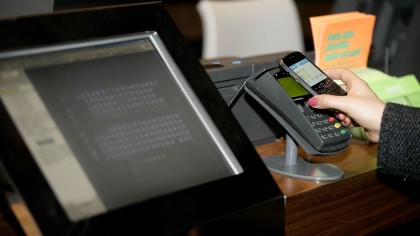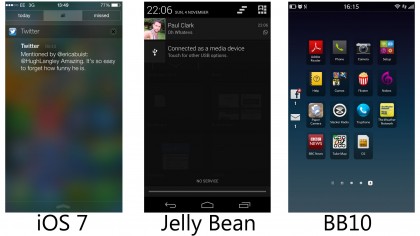iOS 7 vs Android Jelly Bean vs Windows Phone 8 vs BB10
Which is best in the battle of the new platforms?
Downloading apps is also very easy, as Google's rebranded Play Store has become a very attractive and very functional marketplace, with different sections and lists of apps for you to peruse. Auto updating is available, and disable-able too.
The Windows Phone 8 and BlackBerry app stores are far less populated in comparison to both the Google and Apple offerings, although we would be doing them a disservice by calling their offerings sparse (BB10 has 120,000 apps compared to iOS' 900,000), especially given that the Microsoft OS has Xbox compatibility.
Since Android 2.2 Froyo, apps to microSD has been a standard feature, alongside its long supported media storage feature. App installation on microSD is also supported via Windows Phone 8, with standard microSD support also being available in BB10.
NFC
With NFC slowly becoming more prevalent across devices, it has been noticed on the lower end handsets that we have reviewed (LG Optimus L5 2, Huawei Ascend G510, Samsung Galaxy Fame to name but a few), OS support is vital.
NFC wasn't something that wasn't explicitly mentioned with the launch of iOS7. Until now, previous iOS devices haven't come with NFC chips. We could look into this and say things about upcoming iOS touting devices, such as the unlikelihood of NFC inclusion, with the claim that there's 'No need to wander around the room bumping your phone with others.' That said, apps will be able to share information via Airdrop, provided that it supports Share Sheet.

Android has supported NFC for a while. Android Beam has been used on devices to share data since Android 4.0 Ice Cream Sandwich. Certain manufacturers have taken it a little further, with Samsung adding it's S title to create S Beam. Google's wallet application is also likely to make use of NFC as mobile payment becomes increasingly popular.
Windows Phone 8 also packs in NFC support, with its very own Microsoft Wallet app to rival Google's version, and BlackBerry has long had NFC in its handsets so it's no surprise BB10 also makes use of the technology.
Sign up for breaking news, reviews, opinion, top tech deals, and more.
Notifications and Control
Notifications are something that are very important across devices, giving quick access to Calendar events, Emails and Text messages. Device control is equally important.
iOS 7 makes a big deal out of both notifications and Control. The notifications centre that was accessed by swiping down from the top has become a full-screen affair, also available via the lock screen.
The Control Centre is where the real innovation lies, however. Previous iOS versions had a very basic centre, however now quick settings such as Wi-Fi and Bluetooth can be enabled or disabled, as well as controlling screen brightness, music being played, and access to AirDrop and AirPlay controls.

Android has had its notifications bar longer than Apple, so it has come on in leaps and bounds. Jelly Bean also brings in expandable notifications, showing more information about the top event, as well as being able to swipe to dismiss.
Many custom UI's include access to the quick settings (Touchwiz has gotten this nigh on perfect) in the notifications bar. Android also include a Power Control widget that can be placed on home screens, giving quick access to a lot of important settings.
Notifications aren't something that ever made it over to Windows Phone 8, however there are strong suggestions that there is a notifications centre making it over in Windows Phone 8.1. Notifications are viewable from the lock screen.
- Read our in-depth BlackBerry 10 review
With BB10, there is a dedicated Notifications hub, accessed by swiping from the left hand side of the screen, as well as notifications that can be seen for individual apps such as Email, Texts or social networks.
Maps
Given the kerfuffle surrounding the launch of iOS Maps on iOS 6, there was a disappointing lack of map based announcements with iOS7, although 'developers have been making great improvements to Maps', which will bring features such as being able to push mapping info from a Mac of MacBook to an iDevice.